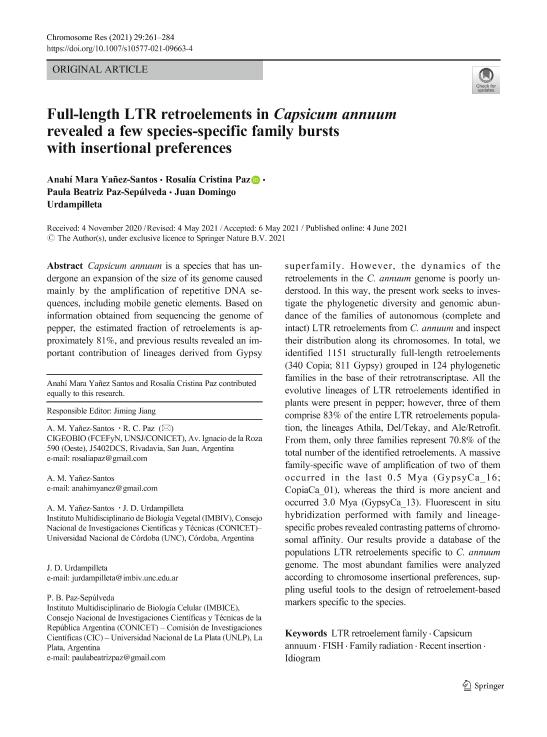Mostrar el registro sencillo del ítem
dc.contributor.author
Yañez Santos, Anahi Mara

dc.contributor.author
Paz, Rosalia Cristina

dc.contributor.author
Paz Sepúlveda, Paula Beatriz

dc.contributor.author
Urdampilleta, Juan Domingo

dc.date.available
2023-01-04T11:46:52Z
dc.date.issued
2021-06
dc.identifier.citation
Yañez Santos, Anahi Mara; Paz, Rosalia Cristina; Paz Sepúlveda, Paula Beatriz; Urdampilleta, Juan Domingo; Full-length LTR retroelements in Capsicum annuum revealed a few species-specific family bursts with insertional preferences; Springer; Chromosome Research; 29; 3-4; 6-2021; 261-284
dc.identifier.issn
0967-3849
dc.identifier.uri
http://hdl.handle.net/11336/183252
dc.description.abstract
Capsicum annuum is a species that has undergone an expansion of the size of its genome caused mainly by the amplification of repetitive DNA sequences, including mobile genetic elements. Based on information obtained from sequencing the genome of pepper, the estimated fraction of retroelements is approximately 81%, and previous results revealed an important contribution of lineages derived from Gypsy superfamily. However, the dynamics of the retroelements in the C. annuum genome is poorly understood. In this way, the present work seeks to investigate the phylogenetic diversity and genomic abundance of the families of autonomous (complete and intact) LTR retroelements from C. annuum and inspect their distribution along its chromosomes. In total, we identified 1151 structurally full-length retroelements (340 Copia; 811 Gypsy) grouped in 124 phylogenetic families in the base of their retrotranscriptase. All the evolutive lineages of LTR retroelements identified in plants were present in pepper; however, three of them comprise 83% of the entire LTR retroelements population, the lineages Athila, Del/Tekay, and Ale/Retrofit. From them, only three families represent 70.8% of the total number of the identified retroelements. A massive family-specific wave of amplification of two of them occurred in the last 0.5 Mya (GypsyCa_16; CopiaCa_01), whereas the third is more ancient and occurred 3.0 Mya (GypsyCa_13). Fluorescent in situ hybridization performed with family and lineage-specific probes revealed contrasting patterns of chromosomal affinity. Our results provide a database of the populations LTR retroelements specific to C. annuum genome. The most abundant families were analyzed according to chromosome insertional preferences, suppling useful tools to the design of retroelement-based markers specific to the species.
dc.format
application/pdf
dc.language.iso
eng
dc.publisher
Springer

dc.rights
info:eu-repo/semantics/openAccess
dc.rights.uri
https://creativecommons.org/licenses/by-nc-sa/2.5/ar/
dc.subject
CAPSICUM ANNUUM
dc.subject
FAMILY RADIATION
dc.subject
FISH
dc.subject
IDIOGRAM
dc.subject
LTR RETROELEMENT FAMILY
dc.subject
RECENT INSERTION
dc.subject.classification
Otras Biotecnología Agropecuaria

dc.subject.classification
Biotecnología Agropecuaria

dc.subject.classification
CIENCIAS AGRÍCOLAS

dc.title
Full-length LTR retroelements in Capsicum annuum revealed a few species-specific family bursts with insertional preferences
dc.type
info:eu-repo/semantics/article
dc.type
info:ar-repo/semantics/artículo
dc.type
info:eu-repo/semantics/publishedVersion
dc.date.updated
2022-09-20T19:21:29Z
dc.journal.volume
29
dc.journal.number
3-4
dc.journal.pagination
261-284
dc.journal.pais
Alemania

dc.journal.ciudad
Berlin
dc.description.fil
Fil: Yañez Santos, Anahi Mara. Consejo Nacional de Investigaciones Científicas y Técnicas. Centro Científico Tecnológico Conicet - San Juan. Centro de Investigaciones de la Geosfera y Biosfera. Universidad Nacional de San Juan. Facultad de Ciencias Exactas Físicas y Naturales. Centro de Investigaciones de la Geosfera y Biosfera; Argentina. Consejo Nacional de Investigaciones Científicas y Técnicas. Centro Científico Tecnológico Conicet - Córdoba. Instituto Multidisciplinario de Biología Vegetal. Universidad Nacional de Córdoba. Facultad de Ciencias Exactas Físicas y Naturales. Instituto Multidisciplinario de Biología Vegetal; Argentina
dc.description.fil
Fil: Paz, Rosalia Cristina. Consejo Nacional de Investigaciones Científicas y Técnicas. Centro Científico Tecnológico Conicet - San Juan. Centro de Investigaciones de la Geosfera y Biosfera. Universidad Nacional de San Juan. Facultad de Ciencias Exactas Físicas y Naturales. Centro de Investigaciones de la Geosfera y Biosfera; Argentina
dc.description.fil
Fil: Paz Sepúlveda, Paula Beatriz. Consejo Nacional de Investigaciones Científicas y Técnicas. Centro Científico Tecnológico Conicet - La Plata. Instituto Multidisciplinario de Biología Celular. Provincia de Buenos Aires. Gobernación. Comisión de Investigaciones Científicas. Instituto Multidisciplinario de Biología Celular. Universidad Nacional de La Plata. Instituto Multidisciplinario de Biología Celular; Argentina
dc.description.fil
Fil: Urdampilleta, Juan Domingo. Consejo Nacional de Investigaciones Científicas y Técnicas. Centro Científico Tecnológico Conicet - Córdoba. Instituto Multidisciplinario de Biología Vegetal. Universidad Nacional de Córdoba. Facultad de Ciencias Exactas Físicas y Naturales. Instituto Multidisciplinario de Biología Vegetal; Argentina
dc.journal.title
Chromosome Research

dc.relation.alternativeid
info:eu-repo/semantics/altIdentifier/url/https://link.springer.com/10.1007/s10577-021-09663-4
dc.relation.alternativeid
info:eu-repo/semantics/altIdentifier/doi/http://dx.doi.org/10.1007/s10577-021-09663-4
Archivos asociados
